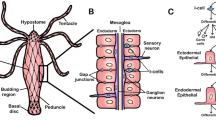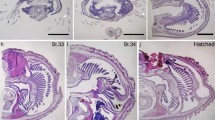Summary
The Structure of the hypothalamic neurosecretory cells during their activity in continuous light and dark conditions and depending on the seasonal alteration has been investigated in Zoarces viviparus L. in the level of light and electron microscopy.
The depletion of AF- or AT-stainable material, of the elementary neurosecretory granules and the disappearance of smooth-surfaced vesicles occur during April and June. The accumulation of the stanable material as well as the elementary neurosecretory granules and the smooth-surfaced vesicles has been observed in the cell body in late September.
An excess increase in number of the smooth-surfaced vesicles of dark-induced animals and light-induced animals kept in a black stained tank is apparent. On the other hand, the disappearance of the elementary granules and the smooth-surfaced vesicles and an enlargement in the reletive nuclear surface of the neurosecretory cells of light-induced animals which were kept in a gray stained tank in April is also evident.
Taking into consideration the responsiveness of both the elementary neurosecretory granules and the smooth-surfaced vesicles in relation to the external environment as well as their topographical arrangement in the cell body the possible differences in their origin and function are discussed.
Numerous studies indicate that the physical environment is in part responsible for the functional properties of the hypothalamic neurosecretory centers of various vertebrates. In the level of light microscope, it has been repeatedly shown that the neurosecretory cells are activated in the animals subjected to continuous illumination, and in those subjected to long daily photo period (Oksche et al., 1958; Fiske and Greep, 1959; Öztan and Gorbman, 1960; Satyanesan, 1965). The enlargement of the nuclei and the amount of Gomori — or aldehyde fuchsin — stainable material, as well as the enzymatic activity, were used as the criteria of cellular activity in the histological preparation. In the level of electronmicroscope it has been shown that Gomori positive material (Bargmann, 1949) is represented as aggregated elementary neurosecretory granules in the ultrathin sections of neurohypophysis (Bargmann et al,. 1957). Although the fine structure of the hypothalamic neurosecretory cells of various fishes and higher vertebrates have been studied in normal and experimental conditions (Palay, 1960; Lederis, 1962, 1964; Follenius et Porte, 1962; Follenius, 1963; Murakami, 1961–1964; Gansler, 1965; Holmes, 1965) the type of granules and their function still remains as an open question (see Bargmann, 1963; Knowles, 1965).
Similar content being viewed by others
References
Bargmann, W.: Über die neurosekretorische Verknüpfung von Hypothalamus und Neurohypophyse. Z. Zellforsch. 34, 610–634 (1949).
—: Neuere Ergebnisse der Neurosekretions-Forschung. Ther. Mh. 13, 198–212 (1963).
—, A. Knoop u. A. Thiel.: Elektronenmikroskopische Studie an der Hypophyse von Tropidonotus natrix. Z. Zellforsch. 47, 114–126 (1957).
—, u. E. Lindner: Über den Feinbau des Nebennierenmarkes des Igels (Erinaceus europaeus L.) Z. Zellforsch. 64, 868–912 (1964).
Bern, H.: The properties of neurosecretory cells. Gen. comp. Endocr., Suppl. 1, 117–132 (1962).
Fiske, V. M., and R. O. Greep: Neurosecretory activity in rats under conditions of continuous light and darkness. Endocrinology 64, 175–185 (1959).
Follenius, E.: Etude comparative de la cytologie fine du noyau Préoptique et du noyau latéral du tuber ches la Perche (Perca fluviatilis L.) Comparison des deux types de Neurosécrétion. Gen. comp. Endocr. 3, 66–85 (1963).
—, et A. Porte: Etude du noyau préoptique de la Perche (Perca fluviatilis L.) au microscope électronique. C. R. Acad. Sci. (Paris) 254, 930–932 (1962).
Gansler, N. H.: Zur Ultrastruktur des Hypophysen-Zwischenhirnsystems der Ratte. Z. Zellforsch. 67, 844–862 (1965).
Heller, H., and K. Lederis: Characteristics of isolated neurosecretory vesicles from mammalian neural lobes. In: Neurosecretion (H. Heller and R. B. Clark, eds.), p. 35–55. London: Academic Press 1962.
Holmes, R. L.: The fine structure of supraoptic neurons of hedgehogs. Z. Zellforsch. 66, 685–689 (1965).
Knowles, F. (Sir.: Neuroendocrine correlations at the level of ultrastructure. Arch. Anat. micr. Morph. exp. 54, 343–358 (1965).
Kumamoto, T., and N. Shimizu: On the effect of light upon the neurosecretory activity of the hypothalamus. Dobytsugaku Zasski 64, 354–359 (1955).
La Bella, F. S., G. Beaulieu, and R. J. Beiffenstein: Evidence for the existence of separate vasopressin and oxytocin containing granules in the neurohypophysis. Nature (Lond.) 193, 173–174 (1962).
Lederis, K.: Ultrastructure of the hypothalamo-neurohypophysial system in teleost fishes and isolation of hormone containing granules from the neurohypophysis of the cod. (Gadus morrhua). Z. Zellforsch. 58, 192–213 (1962).
—: Fine structure and hormone content of the hypothalamo-neurohypophysial system of the rainbow trout (Salmo irideus) exposed to sea water. Gen. comp. Endocr. 4, 638–661 (1964).
Murakami, M.: Electronenmikroskopische Untersuchungen über die Neurosekretorischen Zellen im Hypothalamus von Gecko japonicus. Arch. Histol. jap. 21, 323–337 (1961).
—: Electronenmikroskopische Untersuchungen über die Neurosekretorischen Zellen im Hypothalamus der Maus. Z. Zellforsch. 56, 277–299 (1962).
—: Weitere Untersuchungen über die Feinstruktur der Neurosekretorischen Zellen im Nucleus supraopticus von Gecko japonicus. Z. Zellforsch. 59, 684–699 (1963).
—: Electronenmikroskopische Untersuchungen am Nucleus supraopticus der Kröte (Bufo vulgaris formosus) Z. Zellforsch. 63, 208–225 (1964).
Öztan, N.: The hypothalamic neurosecretory system of a poecilid fish Platypoecilus maculatus and its sterile hybrid backcross with Xiphophorus helleri. Gen. comp. Endocr. 3, 1–14 (1963).
—: The fine structure of the adenohypophysis of Zoarces viviparus L. Z. Zellforsch. 69, 669–718 (1966).
—, and A. Gorbman: The hypophysis and hypothalamo-hypophysial neurosecretory system of larval lamprey and their response to light. J. Morph. 106, 243–262 (1960).
Oksche, A., D. S. Farner, D. L. Serventy, F. Wolff and C. A. Nichols: The hypothalamohypophysial neurosecretory system of the zebra finch, Taeniopygia castatotis. Z. Zellforsch. 58, 846–914 (1963).
—, D. F. Law, and D. S. Farner: The dayly photoperiods and neurosecretion in birds. Anat. Rec. (Abstr.) 130, 443 (1958).
Palay, S. L.: The fine structure of secretory neurons in the preoptic nucleus of the goldfish (Carassius auratus). Anat. Rec. 138, 417–443 (1960).
Porter, K. R.: Observations on a submicroscopic basophilic component of cytoplasm. J. exp. Med. 97, 727–750 (1953).
Satyanesan, A. G.: Hypothalamo-neurohypophysial system in the normal and hypophysectomized teleost Porichthys notatus girard and its response to continuous light. J. Morph. 117, 25–48 (1965).
Scharrer, E., and S. Brown: The formation of neurosecretory granules in the earthworm, Lumbricus terrestris. Z. Zellforsch. 54, 539–540 (1961).
Author information
Authors and Affiliations
Additional information
This work was aided by a grant from Nato and the Deutsche Forschungsgemeinschaft.
This paper was written as a tribute in honor of the 60th birthday of Prof. Dr. Berta Scharrer.
Rights and permissions
About this article
Cite this article
Öztan, N. The structure of the hypothalamic neurosecretory cells of Zoarces viviparus L. under the conditions of constant dark and light during the reproductive cycle. Zeitschrift für Zellforschung 75, 66–82 (1966). https://doi.org/10.1007/BF00407145
Received:
Issue Date:
DOI: https://doi.org/10.1007/BF00407145




